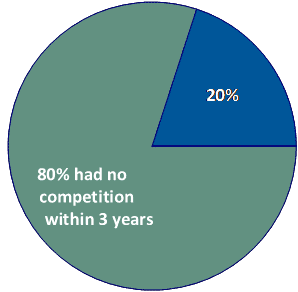3-Year Exclusivity May Not Be Worth as Much as You Think
It is a widely held tenet that market exclusivity is essential for the successful launch of a new drug. But is this always the case? For products approved through the FDA 505(b)(2) pathway, is pursuing the 3-year period of exclusivity available through Hatch-Waxman always necessary? Or is it possible that a product may succeed without 3-year exclusivity?
Through a search of our proprietary database, Premier Consulting looked to see what the data says. The results we found may surprise you.
3-Year Exclusivity
The Hatch-Waxman amendments to the U.S. Federal Food, Drug, and Cosmetic Act [alternate GPO link][codified as 21 U.S.C. § 355(c)(3)(E) (iii)] opened up new possibilities for marketing exclusivity granted by the FDA.
Two primary criteria determine whether this 3-year period of exclusivity is available to New Drug Application (NDA) sponsors:
1) One or more of the clinical investigations submitted in a product’s 505(b)(2) NDA are both new and essential to its approval, and,
2) These clinical investigations were conducted or sponsored by the applicant.1
In general, 3-year exclusivity may:
- prevent early generic competition
- enhance a drug candidate’s valuation as a potential investment target
- improve overall return on investment
But there is a cost. To obtain 3-year exclusivity, multiple qualifying clinical trials are often required. These studies are valuable when they support a new indication that delivers significant commercial revenues, but if they are conducted primarily to obtain 3-year exclusivity, they may not be worth the added time and expense.
A Look at the Data
Premier Consulting keeps a current and comprehensive database of FDA 505(b)(2) product approvals, including those with and without Hatch-Waxman exclusivity.2 Our team reviewed the data for these products to determine which faced generic competition3 and in what timeframe.
In the investigation, we identified 221 approved 505(b)(2) products without 3-year exclusivity. Nearly 80% (175 of 221) of the products approved under 505(b)(2) without exclusivity had no competition within the first 3 years after approval (Figure 1). Adding to that, only 11% (25 of 221) of these products had competition after 3 years (Figure 2).

Figure 1: 505(b)(2) Products without 3-Year Exclusivity that Experienced Generic Competition within the first 3 years

Figure 2: 505(b)(2) Products without 3-Year Exclusivity that Experienced Additional Generic Competition after 3 years
You may find the results equally surprising for products with 3-year exclusivity. From a sample of 174 505(b)(2)s with 3-year exclusivity, 6% (11 of 174) had competition within the first 3 years after approval. For these 11 products, their competition came from other drugs with minor and allowable differences.
From our studies, we can conclude 3-year exclusivity isn’t always necessary or an appropriate use of resources. There are times when 3-year exclusivity can offer a market advantage but it is only one factor in determining the success of a 505(b)(2) development candidate.
Proof in the Marketplace
One example of success with an approved product without Hatch-Waxman 3-year exclusivity is 24-hour Allegra-D® Allergy & Congestion. It was approved under the 505(b)(2) pathway as an extended-release fexofenadine/pseudoephedrine tablet in 2004. 24-hour Allegra-D® Allergy & Congestion now has eight ANDAs for similar fexofenadine/pseudoephedrine allergy products, but 24-hour Allegra-D’s earliest competitor was not approved until almost five and half years after its own original 505(b)(2) approval.
Another example of delayed competition for a product without 3-year exclusivity is Fludeoxyglucose F18, an injectable radiopharmaceutical used for diagnostic purposes in combination with Positron Emission Tomography imaging. Fludeoxyglucose F18 was approved in 2005 via the 505(b)(2) pathway, and although there are now 31 ANDAs for similar products, Fludeoxyglucose F18 also enjoyed approximately five and half years of exclusivity before the first competitor ANDA was approved.
To Pursue, or Not Pursue?
With multiple factors to take into consideration, how can a developer, executive, or investor know whether 3-year exclusivity is worth pursuing for a potential drug candidate?
While there is not always a clear-cut answer, Premier Consulting can help shed light on the complex strategic development and regulatory questions. With our unique database and unmatched FDA interactions, Premier Consulting knows the 505(b)(2) process more intimately than anyone else and can determine whether Hatch-Waxman exclusivity is worth the investment in time and money.
From the first critical decisions, through the entire development process, to regulatory approval and beyond, no other partner is better equipped to help your product succeed than Premier Consulting, the global 505(b)(2) experts.
1 Bioavailability and bioequivalence studies do not qualify as clinical investigations “essential to approval” under this stipulation for 3-year exclusivity qualification.
2 Premier Consulting maintains a proprietary database for 505(b)(2) NDAs occurring since 2003.
3For the purposes of this article, “competition” is defined as an ANDA or other 505(b)(2) with the same dosage form (as listed on Drugs@FDA) approved after the initial 505(b)(2) NDA. This analysis does not take into account competing products that were on the market prior to the initial 505(b)(2) product’s approval.